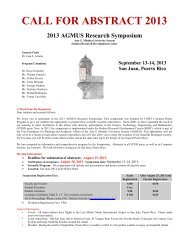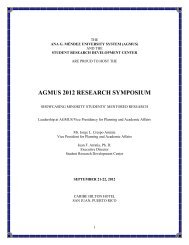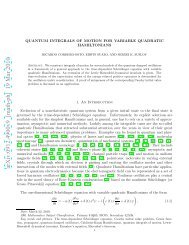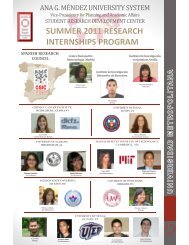WINTER 2008 PRE-COLLEGE RESEARCH SYMPOSIUM - Student ...
WINTER 2008 PRE-COLLEGE RESEARCH SYMPOSIUM - Student ...
WINTER 2008 PRE-COLLEGE RESEARCH SYMPOSIUM - Student ...
Create successful ePaper yourself
Turn your PDF publications into a flip-book with our unique Google optimized e-Paper software.
<strong>RESEARCH</strong> MENTORS<br />
Dr. Juan F. Arratia<br />
Executive Director<br />
<strong>Student</strong> Research Development Center<br />
Principal Investigator<br />
AGMUS Institute of Mathematics<br />
Universidad Metropolitana<br />
Dr. Juan F. Arratia was born in Pomaire, Chile. He graduated from Universidad Técnica del Estado with<br />
a BS in Electrical Engineering in 1973. He was awarded an MSc in Engineering from Louisiana Tech<br />
University, Ruston, Louisiana, in 1979 and a Ph.D. in Electrical Engineering from Washington University,<br />
St. Louis, Missouri in 1985. He has taught and conducted research at universities in Chile (Universidad<br />
Técnica del Estado and Universidad Austral de Chile), Puerto Rico (Universidad Interamericana de Puerto<br />
Rico and the University of Puerto Rico-Mayaguez), and in the US mainland at Washington University, St.<br />
Louis, and Louisiana Tech University, Ruston, Louisiana. He has lectured and given conferences on<br />
advanced automation, robotics, vision systems, artificial intelligence, total quality management and science<br />
and engineering education in Chile, Bolivia, Ecuador, Guatemala, Panama, Mexico, Brazil, Nicaragua,<br />
Perú, Canada, Spain, the Netherlands, Turkey, Japan, Philippines, Singapore, Australia, China, Puerto Rico<br />
and in the US mainland. He was the Advanced Manufacturing Manager for Medtronic, Inc., a leading<br />
pacemaker company, and is a consultant in advanced automation for pharmaceutical and medical devices<br />
companies in Puerto Rico. Since 1998, he has been the Director and Principal Investigator of the Model<br />
Institutions for Excellence (MIE) Project, a National Science Foundation sponsored program based at<br />
Universidad Metropolitana in San Juan, Puerto Rico. Since 2007, he is the Executive Director of the Ana<br />
G. Méndez University System (AGMUS) <strong>Student</strong> Research Development Center, designed to disseminate<br />
MIE best practices at Universidad del Turabo and Universidad del Este. In November 2007 he was awarded<br />
the Presidential Award for Excellence in Science, Mathematics and Engineering Mentoring at a ceremony<br />
in the White House in Washington DC.<br />
Dr. José Cernicharo Quintanilla<br />
Spanish Research Council (CSIC)<br />
Dr. José Cernicharo Quintanilla studied his Bachelor’s and Master’s Degrees in Physics at Universidad<br />
Complutense de Madrid and his Ph.D at the Université de Paris VII. He has worked in the Observatories of<br />
Meudon (1979, 1981-1982), Bordeaux (1980-1981), Grenoble (1982-1988), Institut D'astrophysique de Paris,<br />
Max Planck Institut Fur Radioastronomie in Germany, Observatoire de Bordeaux, IRAM, the Yebes Astronomical<br />
Center, Institute of Technology of California (CALTECH), INAOE in Puebla, Mexico, Observatoire de Paris, and<br />
at the CSIC. His most recent publications for <strong>2008</strong> include: A Detailed Analysis of the Dust Formation Zone of<br />
IRC+10216 Derived from Mid-IR Bands of C 2 H 2 and HCN; Detection of Circumstellar CH 2 CHCN, CH 2 CN,<br />
CH 3 CCH, AND H 2 CS; Search for Anions in Molecular Sources: C 4 H - Detection in L1527; Discovery of C 3 N - in<br />
Space; The Molecular Hydrogen Explorer H2EX; Physical Parameters for Orion KL from Modelling its ISO High<br />
Resolution Far-IR CO Line Spectrum; Tentative Detection of Phosphine in IRC +10216; Formation of Simple<br />
Organic Molecules in Inner T Tauri Disks; Solving Radiative Transfer with Line Overlaps Usin the Gauss-Seidel<br />
Algorithms; Star Formation in the Trfid Nebula Cores and Filaments; and Millimetron-A Large Russian-European<br />
Submillimeter Space Observatory. He has offered many conferences in schools, universities, astronomy<br />
associations, at national meetings, cultural associations and in different countries. His scientific research has been<br />
in the news in Europe, in the Science journal, and in local and international newspapers.<br />
10








